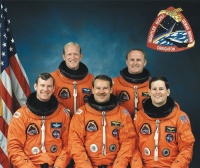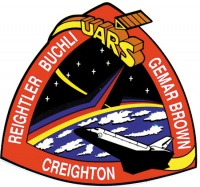STS-48
From The Space Library
 | |
| Organization | NASA-Office of Space Flight (United States) |
|---|---|
| Mission type | Human Crew |
| Launch date | September 12, 1991 |
| Launch vehicle | Space Shuttle |
| Launch site | Cape Canaveral, United States |
| COSPAR ID | 1991-063A |
| Inclination | 57 degrees |
| Experiments | Here |
| Alternate Names | 21700 |
| Additional Information | Here |
| Data Collection | Here |
| Payload Mass Up | 7854 kg |
| Payload Mass Down | 1317.27 kg |
| Orbiter | Discovery |
| Lift Off Mass | 2,048,794.55 kg |
| Orbiter Weight at Liftoff | 108,970.45 kg |
| Orbiter Weight at Landing | 87,503.18 kg |
| Landed | Concrete runway 22 at Edwards Air Force Base, Calif. |
| Orbits of Earth | 81 |
| Orbital Altitude | 308 nautical miles (355 statute miles) |
Contents |
[edit] Crew
- Commander: John O. Creighton
- Pilot: Kenneth S. Reightler Jr.
- Payload Commander:
- Mission Specialist 1: James F. BuchIi
- Mission Specialist 2: Mark N. Brown
- Mission Specialist 3: Charles D. "Sam" Gemar
- Mission Specialist 4:
- Mission Specialist 5:
- Payload Specialist 1:
- Payload Specialist 2:
ISS/Mir Crew Transport
[edit] Mission
STS 48 was the thirteenth Discovery flight. On board were Astronauts John Creighton, Kenneth Reightler, Mark Brown, James Buchli, and Charles Gemar. The mid-deck payload consisted of the Physiological and Anatomical Rodent Experiment (PARE) wad the Protein Crystal Growth (PCG) experiment. The Upper Atmosphere Research Satellite (UARS) was launched to study physical processes acting within and upon the stratosphere, mesosphere, and lower thermosphere. Discovery landed in California on September 18, 1991. The mission duration was 128 hours, 27 minutes, 51 seconds.
[edit] EVA
[edit] Payload
Upper Atmosphere Research Satellite (UARS); Ascent Particle Monitor (APM)-03; Physiological and Anatomical Rodent Experiment (PARE)01; Protein Crystal Growth (PCG)-ll-2; Middeck Zero-Gravity Dynamics Experiment (MODE)-01; Investigations Into Polymer Membrane Processing (IPMP)-04; Cosmic Radiation Effects and Activation Monitor (CREAM-02); Radiation Monitoring Equipment (RME)-lll-06; Shuttle Activation Monitor (SAM)-03; Air Force Maui Optical Site (AMOS) Calibration Test
[edit] Books about the Space Shuttle Program
Buy This Book Click here |
Buy This Book here |
Buy This Book Click here |
Buy This Book Click here |





